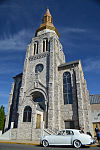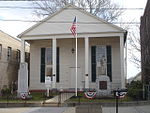Washington Canal (New Jersey)
Canals in New JerseyCanals opened in 1825Geography of Middlesex County, New JerseyNew Jersey transportation stubsSayreville, New Jersey
The Washington Canal, in Sayreville, New Jersey, is a waterway connecting the South River with the Raritan River, bypassing several loops at the mouth of the former. It was chartered in 1823 to reduce the distance and hence travel time along the South River from South River, New Jersey (then known as Washington) to the Raritan River, and built about 1824–1825.During Hurricane Sandy, the area around the Washington Canal suffered surges up to 14 feet above flood stage. Nearly all homes became uninhabitable, and more than 30 lost their foundations.
Excerpt from the Wikipedia article Washington Canal (New Jersey) (License: CC BY-SA 3.0, Authors).Washington Canal (New Jersey)
Junker Street,
Geographical coordinates (GPS) Address Nearby Places Show on map
Geographical coordinates (GPS)
| Latitude | Longitude |
|---|---|
| N 40.4662 ° | E -74.3718 ° |
Address
Junker Street
Junker Street
08872
New Jersey, United States
Open on Google Maps







